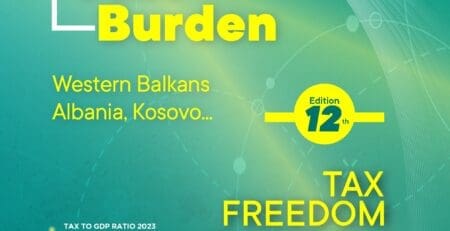Restoring market stability and maintain financial stability, but…
When there is a shock to the market accompanied by an increase in the costs of financing it, add the moment when inflation is high, then the tension between the objective of low inflation of the Central Bank and price stability and financial stability is inevitable. In such cases, financial stability must come first, because from all experience it is a prerequisite for the effective pursuit of price stability.
This means that the Bank of Albania (BoA) must continue its anti-inflationary policies while managing at the same time the conflict between the objective of price stability and financial stability. The instrument used, that of increasing the interest rate for 1 year now, as a measure aimed at reducing inflation, is also supported by the size and effect of the BSH balance sheet, as a macroprudential political tool to aim for financial stability.
Our analysis begins with this case to discuss whether it is a concern when the balance sheet of the Bank of Albania results in a loss [1] based on the impact it tries to have on price stabilization and the financial market?
The discussion is worth having since in fact the Central Banks themselves must mitigate the risk of misperception of this moment through effective communication with their stakeholders. They can clarify the context for potential losses, pointing out how measures were taken to guarantee price stability in the medium and long term for the benefit of households and businesses.
In public communications, the Central Bank should prepare stakeholders for the loss according to the financial statements of 2022, explaining that the assets from which its income results were in other programs that carried financial risk.
In this period of financial market uncertainty, citizens, businesses, commercial banks, investment funds, etc. once they participated in bond and bond auctions, the value of going public, even repeating messages when losses are inevitable, takes on an important meaning simply by clarifying how central bank finance works and that losses are not relevant to monetary policy (or vice versa).
When there is uncertainty about how the Central Bank’s losses will be handled, misunderstandings can also arise and erode its credibility. This underscores the importance of having consistent financial communication so that stakeholders understand the unique nature of a Central Bank’s finances considering its mandate.
Although financial stability does not depend on and is affected by the result of the balance sheet of the Bank of Albania beyond what was commented above, the object of this analysis is in the answer related to how to better address the objective of reducing inflation without damaging the performance of economy and consumption.
In the absence of a communication based on studies, there is a perception that the large supply of money in the market may have influenced, together with the excessive presence of informal money, the negative financial result of 2022.
Financial stability in an economy is not materially affected by the loss result until a point that constitutes a recurring management risk.
In a large, advanced economy, even an increase of 0.5 basis points in the nominal short-term interest rate does not affect the financial stability of the economy.
In the case of a small and developing economy, interest rate increases, as happened with the decision by the BoA Supervisory Council in March 2023 [2], have different impacts than in the case of large and advanced economies.
We think the main reason is related to the recent increases in the base interest rate, which have not steadily lowered the inflation curve.
Based on this weak effect, the Bank of Albania should consider accompanying policies that should be more special and more dedicated than the policies approved by the ECB or the Federal Reserve in the USA.
First, we suggest that the policy of quantitative easing (QE) [3] but combined with the policy of quantitative easing (QT) [4], which have been implemented by the money market with a massive explosion of money supply that has not been seen since at least 2010, as well as the BoA with its tightening policy.
The reason for the suggestion stems from the fact that the cautious response of the Bank of Albania and the interaction with the Ministry of Finance have not been able to respond to the challenges of the market since all decision-making has had insignificant effect on curbing inflation without consequences on curbing economic growth.
The actions of the two institutions have not sufficiently taken into consideration the impact of the market from the informal economy and money, as well as the structural weaknesses of the economy.
In these conditions, the growing pressures for spending demand a long-term response and not isolated actions that cannot meet when and as much as the expectations of consumption and public confidence.
In conditions where the role of pumping liquidity in the financial market has been made by the informal market (so not CB), the policy of quantitative withdrawal from it, with the effect of withdrawing liquidity from the market, makes it more unstable, increasing the demand for money and risk-free assets. This, instead of weaker lending, is the reason for a risk present in the market even in 2023.
Secondly, the biggest problem, expressed by experienced experts of the financial market, but also analysts from the economic media have expressed reservations regarding the fact that in recent years the second level banks have had more deposits than they wanted to have, which has caused problems with their capital requirements. Whenever banks have given out loans in the main form of overdrafts, they have thrown in new money that has been added to the overall money supply of the economy.
But now when the banks are already oversaturated, they are looking for how to manage this situation exactly, which is much more difficult than if they were in conditions of lack of liquidity.
Banks for several years, in some way, have pushed customers towards the sources of the free money market, trying not to keep the risks of the uncertainties of the Albanian economy within their banks.
These money market sources (clean and dirty), in turn, have made more money available to market credit demands.
The way the transaction is carried out is that these money market financings are already lending to citizens and formal businesses that are naturally part of deposits in various banks.
In fact, at this moment, if the second level banks had effective cooperation with institutions such as ML Authority and Tax administration, etc., these out-of-control transactions should be stopped. But, in the case when this does not happen, then the following transaction must be carried out, where the same amounts are withdrawn from the reserve account of the banks that have it deposited in BSH and in this finalization of the transaction steps, the bank’s reserves in BoA fall and the accounts creditors and debtors between them are equalized.
Thirdly, although the fiscal policy does not affect economic growth and cannot implement the ambitious programs that started at least 5 years ago if it is not supported by the creation of credit, credit also needs support and security from the performance of to the government.
It’s time again to talk about the risks, since for several years the need for credit due to huge projects in infrastructure, energy, civil constructions has increased the demand for money, but on the other hand, the government in just these last 7 years has took 5 times external debt by throwing that monetary supply in the market, in addition to what comes from banks and the informal money market.
Thus, these approaches to the market have created a valuable environment to implement policies such as “Pinocchio’s money tree”, since they have not been pumped for productive purposes (lending to businesses).
If government debt, bank loans and lending from non-banking institutions and investment funds were used for productive business investment such as loans to small businesses and productive businesses, then we would have massive job openings, higher wages generated from productive work, thus sustainable economic growth. Moreover, if this growth were to be injected into the economy through many small banks (the banking market already consists of large banks) to more small and medium-sized businesses, then there would be additional benefits that would orientate a more property rights/welfare for all.
Conversely, if the economy’s lending scenario is used for non-productive purposes such as trading financial assets (including bonds) or real estate, this leads to asset price inflation and the real estate market, i.e. a form of “bubble” economy that could trigger a banking crisis if the boom is big enough.
Similarly, if credit from all credit sources (government, banks, free market) is created primarily to support household consumption, this will inevitably result in consumer price inflation.
Unfortunately, in Albania, but also in many other countries, especially those with few large banks, there has been a significant shift in bank credit from lending for productive business investments to lending for asset purchases. While the big banks want to make big deals, bank lending for asset purchases now makes up most of the lending, ironically “cutting down” the tree they are standing on.
The prevention of these symptoms can be seen as a solution only in the implementation of the regulatory framework managed by the Bank of Albania, which must restore the vigilance that was needed by the counterpart institutions in developed countries in the cases of the beginning of the financial crises of the last decades.
Fourth, in the first case, BoA and the central financial institutions should open a big discussion to start the resizing of the banking market, as it needs to change. The Albanian market also needs small banks, which manage to be effective lenders for small and medium-sized businesses.
The reason is that the banking sector with big banks will not give loans to small businesses, as they target big projects and big businesses.
However, most of the employment in the economy is with small businesses, which we suggest will only thrive if we have a decentralized banking system with many small local banks alongside the big ones.
In this case, it is enough to take the example from the system of local banks in Germany (Volksbanken).
Although there are no more local banks in Albania, we must gather and create new ones, as the market and the economy need them.
[1] https://www.reporter.al/2023/04/13/banka-e-shqiperise-mbyll-vitin-me-278-milione-euro-humbje/
[2]https://www.bankofalbania.org/Shtypi/Njoftime_te_mbledhjeve_te_Keshillit_Mbikeqyres/Njoftime_mbi_vendimmarrjen_e_politikes_monetare/Vendimet_e_politikes_monetare_34438.html
[3] QE works by injecting liquidity into the financial market, but this increase in liquidity is not said to encourage lending. When, during the QE transaction, the Central Bank (CB) buys a treasury bond from investors, the transaction is carried out through an intermediary, i.e. a bank. The sale proceeds are a customer deposit in that bank and is a liability. At the same time, the bank is credited with a reserve deposit in CB for the same amount and is an asset.
Because a bank will always have fewer reserve assets in CB than deposit liabilities, adding the same amount to either will increase the bank’s reserve/deposit ratio.
QE improved the bank’s liquidity in this sense.
A bank that has more liquidity has an incentive to lend. They don’t have to lend more, but they have reason to optimize their balance sheet.
[4] the opposite of quantitative easing, which is accomplished by selling government bonds/bonds, or letting them mature and removing them from the CB’s cash balances.




Leave a Reply
You must be logged in to post a comment.